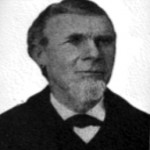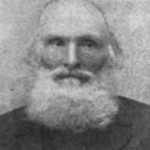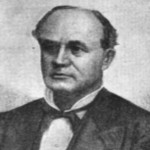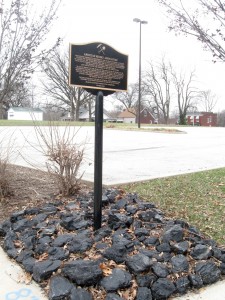
By CARL GREEN
Illinois Correspondent
Belleville – This has always been a good union region, no doubt, but what if someone said that Belleville – and St. Louis, by extension – is where the national labor movement got its start?
It might seem like a stretch. Not Pittsburgh? Not Detroit? Not New York City or Boston?
But history makes the case that the first truly national labor union started right here – the American Miners’ Association (AMA), now a mostly forgotten forerunner of the United Mine Workers of America.
The case for the AMA is laid out in an article being published this month in the St. Clair County Historical Society Journal, written by local historian Jack Le Chien, entitled, “American Miners’ Association of West Belleville: The first U.S. national labor union and, arguably, the beginning of the modern labor movement.”
Le Chien has pored through old newspaper articles and obscure books to tease out the story of the AMA, which probably rose before its time and certainly fizzled out too soon. Englishmen working as miners in the town of West Belleville founded the union at a meeting in St. Louis on Jan. 28, 1861, benefitting from wartime economic conditions that gave workers some fleeting negotiating power. After rapidly expanding into several other coal-producing states – thus creating the first national labor union – the AMA had fallen thoroughly apart by 1869.
What it left behind were genuine improvements in safety, pay and fairness for workers, something of a blueprint for national unions that would follow and stay together for the long haul.
Maybe it was never meant to be – until the war came about. Even then, it wasn’t meant to last.
* Story continues under advertisement.
Le Chien explains: “The Civil War created a real booming economy, and of course guys are going off to fight and there’s a shortage of coal miners, so these guys did have some leverage in negotiating, and that lasted until ’69 or so,” he told the Labor Tribune. “The boom of the Civil War all came to an end; there was a huge economic adjustment, and all that inflation from those war years just came to a halt.”
A SEED IS PLANTED
Belleville is known for its German population, but the AMA was founded by a bunch of English miners who had come here for the opportunity to work. They were dismayed by the working conditions, which were exceedingly dangerous and totally unregulated.

AMA founders Daniel Weaver and Thomas Lloyd were known as hard workers and strong speakers. They were also adherents to the Chartist Movement, essentially a massive workingman’s revolt that pushed Great Britain in the direction of real democracy in the 1830s through the 1850s before finally coming undone. The Chartists called for six changes, of which five are now standard functions of democratic states:
- The vote – A vote for every man of sound mind and at least 21 years old. Women’s suffrage would come later.
- The secret ballot – Protection for voters from retribution for their choices.
- No property requirement for Parliament – Voters thus choose the candidate of their choice and not be limited to landed noblemen.
- Payment of representatives – Working men could not afford to run for office without being paid for their time.
-

LLOYD Equal representation – Assuring equal populations within electoral districts kept a few noblemen from holding sway over larger groups of people.
- Annual elections – Chartists reasoned that by electing members to Parliament annually, they wouldn’t be able to get away with bribery and intimidation. This was the only proposal of the six that never became law, although it is echoed in the two-year terms of the U.S. House of Representatives.
It was from these democratic beliefs that Weaver, Lloyd and their friends set out to improve the lot of miners working in West Belleville, a newly founded town just north of the original Belleville. In West Belleville, the mines, streets, water wells and residents ran side by side, and the town grew rapidly before the Civil War as miners flocked from all over.
Before the AMA, local unions were sometimes formed around individual mines, but there was no cooperation between them, and they didn’t have much impact. By 1860, Weaver and Lloyd were eager to take action, and they seem to have had a larger organization in mind all along.
THE PAY CUT
The coal companies then provided all the incentive the miners needed. They cut pay by a quarter-cent, to two cents per bushel, which the workers accepted grudgingly but silently. Then the companies tried to do it again, and the AMA core jumped into action, calling a meeting that would prompt not only a successful strike but also found the union itself.
The pay cut was rolled back, and miners began flocking to the union. Weaver moved on to two other key issues – fair weighing of the coal being produced, which could cost a miner 30 percent of his rightful pay, and mine safety.
The union grew swiftly. At first it was mostly Englishmen, but soon enough the Germans were joining as well.
“There’s power in numbers,” notes Le Chien. “The Germans who first came here didn’t want to join because they were the newest guys and they would be the first fired if they joined the union. But within a couple of months, they begin to see that this is going to work. Weaver is really exhorting them that they have to stay together. They do begin to understand the power of numbers, and if it means you have to sit out and go on strike, well, that’s what we have to do.”
The Chartist Movement was a regional movement that grew into a national campaign, so it perhaps is no surprise that the new union quickly got to the work of planting lodges in other coal-mining regions, including St. Louis, LaSalle in north-central Illinois and Braidwood further east toward Chicago, followed by branches in Ohio, Indiana and Pennsylvania. Madison County and other parts of St. Clair County also had lodges.
A BETTER LIFE
Part of the union’s appeal was that Weaver had more in mind than pay and working conditions. He was seeking to improve the lives of the members.
“Coal miners were notorious for getting drunk after work – you had to cut that coal dust some way,” Le Chien said. “He tried to appeal to their better sense, that we could become one and learn things together and serve our community, and that’s how it starts with about 50 guys in Belleville and grows to 20,000 in about an eight-year period.”
The union had immediate success also in using a petition drive to convince the Legislature to appoint independent “coal sealers,” to be paid by the companies to weigh coal coming up from the mines and see that miners were compensated fairly. This was another major victory for the union.
A key factor in the union’s fast growth was its publication, beginning in 1863, of the Weekly Miner, a newspaper that reported to members on events and activities from throughout the union.
The editor, John Hinchcliffe, was not a coal miner himself, but he succeeded in spreading the word about the union, traveling through eastern states to found new lodges. In short order, the union changed its name from Miners’ Association to American Miners’ Association to reflect its wider reach. Weaver eased out of the leadership because he had become part-owner of a mine, and Hinchcliffe became the union’s leader.
EARLY SUCCESSES

The union pushed a bill through the Illinois Senate to improve ventilation and remove noxious gases. The bill was blocked in the House, but in 1873, Hinchcliffe, by then serving as a legislator, was able to get it passed over much company opposition.
The year 1863 saw a successful series of strikes in northern Illinois, upsetting the coal companies further. In 1864, the AMA held a national convention in Cincinnati.
But by the time the war ended in 1865, the companies were ready to fight back against the union. Soldiers were returning home to their old jobs, ending the war-time labor shortage. War-time industrial production ground to a halt, reducing the demand for coal. Suddenly, the factors that had supported the union in its strikes against the companies were working against them.
Internal conflicts raised their head about this time, as well, further weakening the union. At the 1865 national convention, in Cleveland, Hinchcliffe lost his national leadership role – and the newspaper soon thereafter.
Le Chien explains: “The guys who are now in power after this convention in Cleveland get rid of Hinchcliffe because they don’t like what he’s saying in the newspaper. Then there’s a revolt against that by people back here, saying ‘We want a paper and we want him in charge.’ I think that’s kind of the beginning of the end of the union, when they start this internal bickering.”
Hinchcliffe tried to start a new paper in St. Louis, called The Miner and Artisan, but it lasted only until July, 1866. The Weekly Miner ended, as well, and no copies of it remain.
LAST YEARS

The last years of the AMA were marked by disastrous strikes that the union could not win, given the changed economic climate. One in Pennsylvania went on for five months, leading to the elimination of AMA in that region. By 1869, it was all over.
But like the Chartists who inspired them, the union’s legacy continued to grow after its demise until mines were safer and miners were treated better.
For one thing, Hinchcliffe was elected to the Illinois House in 1871 and pushed through much legislation helping miners before his death in 1878. One bill, for instance, tightened enforcement of the “coal sealer” law from the union’s early successes.
Other attempts were made to form a miners’ union, and one finally broke through – the United Mine Workers of America, founded in 1890 in Columbus, Ohio, by the merger of two other unions.
The UMW acknowledged the role of the AMA in a 1930s journal article that Le Chien quotes:
“Growing out of a strike protesting against wage reductions, the American Miners’ Association was the militant granddaddy of the United Mine Workers of America. That pioneer national union was a product of the industrial revolution then opening a new chapter in American history.
“This early union was called upon to solve such familiar problems as recurring recessions, unemployment, wage reductions, and insecurity of living standards. The American Miners’ Association is linked with the United Mine Workers of America because, despite the span of years separating them, both felt a concern for the same social and economic conditions spewed by industrialism …”
“The American Miners’ Association was unique, because in outlook and policy, it was ahead of the typical labor union of its time in the 1860s.”
FINDING THE STORY
The AMA could have been mostly forgotten if not for the work of a former miner named Edward Wieck, from Staunton, IL, who in 1938 researched the union, doing much of his work in the same Belleville library where Le Chien can often be seen. Wieck’s book, The American Miners’ Association, a Record of the Origins of Coal Miners’ Unions in the United States, was published in 1940. A copy can be found in the reference department of the Belleville library, and it served as a major source for Le Chien.
Le Chien’s article is mostly concerned with the story of the AMA, but he also takes time to describe the life of coal miners in Belleville, including the dangers they faced, the tools they used, and their sports and recreational activities away from the mines. His research began in 2014 while preparing a successful National Register of Historic Places proposal for West Belleville, which is now part of the larger city and notable for its many German-style street houses – working people’s homes that were built up to the sidewalk in front but left room in back for gardens and animals.
“I was looking through different things, and American Miners’ Association came up, and I got to this book and on the first page, the guy (Wieck) says, ‘… the beginning of the modern labor movement.’ That sort of jumps out at you.”
THE MARKER
Another result of the work is that the Belleville Historic Preservation Commission last fall joined with the city to create a plaque mounted over a pile of coal by a parking lot at 9th and West Main streets, honoring the AMA. The parking lot was the site of Huff’s Beer Garden, one of the miners’ favorite haunts.
Le Chien is particularly fascinated by the founder Weaver, who brought some philosophy into an economic fight.
“He writes these very eloquent letters to the miners, and it’s not just, ‘We’ve got to get more money,’ he’s talking about them improving themselves as human beings.”
For information about obtaining Le Chien’s article or joining the St. Clair County Historical Society, go online to stcchs.org.


